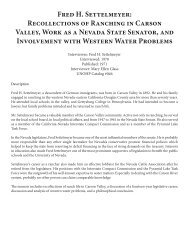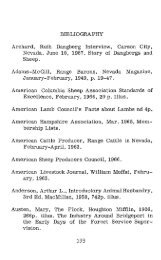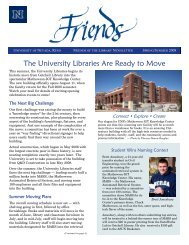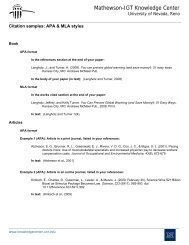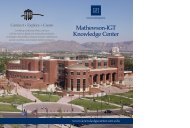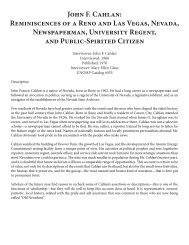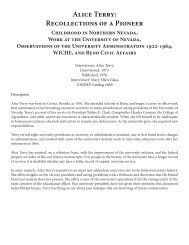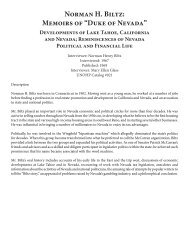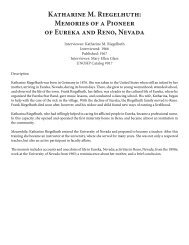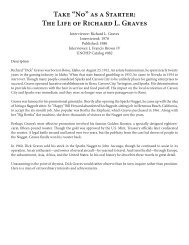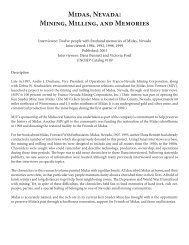Silvio Petricciani - University of Nevada, Reno
Silvio Petricciani - University of Nevada, Reno
Silvio Petricciani - University of Nevada, Reno
Create successful ePaper yourself
Turn your PDF publications into a flip-book with our unique Google optimized e-Paper software.
50 <strong>Silvio</strong> E. <strong>Petricciani</strong><br />
and down below us was a settlement <strong>of</strong> some<br />
kind. So I started to spiral down through the<br />
hole, got down, and I found out that we were<br />
over—well, what we had originally planned to<br />
do was go from Las Vegas to Salt Lake, back<br />
to Provo, and Provo back to Las Vegas which<br />
was a triangle. We find ourselves instead <strong>of</strong><br />
Salt Lake being up here, we were over here<br />
over Provo. We were forty miles to the east<br />
and forty miles south. We had never gotten<br />
to Salt Lake, and we were forty miles east.<br />
Well, the reason for that was that every time<br />
you pass what you call a squall line on a cold<br />
front—the cold front was moving this way,<br />
west to east, and we were going north, so you<br />
get a definite wind shift. And the wind took<br />
us in effect—when on a low, then the wind<br />
goes counter-clockwise, and on a high, the<br />
wind goes clockwise. So what happened was,<br />
we got into this low and we were brought up<br />
over around this way; instead <strong>of</strong> being able<br />
to fly directly why the squall just brought us<br />
over that way and a head wind.<br />
So, I said to Oscar, I said, “Well, Oscar,<br />
we’re over Provo now.” I said, “Let’s just land<br />
here, wait’ll this thing blows over.” And this<br />
is something that I learned that day: you<br />
never have to get someplace; there’s always<br />
tomorrow.<br />
Oscar said, “No.” He says, “Let’s go.” He<br />
says, “Let’s go back up through the hole,” he<br />
says, “I’ve got to get back to work tonight.”<br />
That was mistake number two.<br />
First place—first mistake was that I never<br />
should have gone any further north than<br />
Milford, Utah. That was mistake number two;<br />
I said, “Okay.” So the only instrument time that<br />
I had had, I’d had with my instructor. He flew<br />
me through one cloud down in California,<br />
and at that time we had basic instruments<br />
which was needle, ball and airspeed. Needle,<br />
ball is nothing more than an inclinometer<br />
which is a little ball that sets on a curve, and<br />
then the needle is gyroscopically controlled<br />
and it sits straight and always points to the<br />
horizon unless you’re making a turn. When<br />
you’re making a turn, it displaces the needle,<br />
and it shows that the airplane, as the needle<br />
goes over to the right side, it shows that you’re<br />
turning to the left and vice versa. I’ll show that<br />
to you sometime next time we fly.<br />
And your airspeed, <strong>of</strong> course, lets you<br />
know whether You’re going up—if you go<br />
up you go slower—and if you are diving, you<br />
go faster. And you know what your normal<br />
airspeed is when you’re flying straight and<br />
level, so the variation <strong>of</strong> those two. This was<br />
what pilots flew on instruments—needle, ball<br />
and airspeed. Some <strong>of</strong> them were lucky to<br />
have an artificial horizon; we didn’t.<br />
So anyway, one thing leading to another,<br />
I started up. Oh, your compass, <strong>of</strong> course,<br />
anyway to give you your course. But this was<br />
an old wet compass that bobbles around all<br />
over, and it’s subject to different magnetic<br />
disturbances from the ground and also<br />
magnetic north, but it gives you a fair idea <strong>of</strong><br />
which way you’re going. So, away we go back<br />
up through the hole.<br />
Well, there again comes the expression,<br />
“sucker hole,” because many a pilot’s been<br />
killed by getting into weather and seeing this<br />
great big hole opened up where you can see<br />
sunshine through the other side, you know.<br />
He says, “There’s my out,” and he goes towards<br />
it and just about the time he gets there, some<br />
little angel up in heaven just comes in and just<br />
closes that whole thing up. That’s what you<br />
call a “sucker hole.” And when it closes up,<br />
there you are in the clouds. But this is what<br />
happened to me.<br />
But I did remember this ten minutes <strong>of</strong><br />
flying through the cloud in California, and<br />
I held the needle steady and the ball in the<br />
middle. The ball lets you know whether you<br />
are slipping around the turn or something. As



